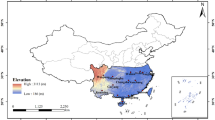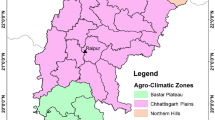Abstract
The study investigates the ability of artificial neural networks (ANN) with artificial bee colony (ABC) algorithm in daily reference evapotranspiration (ET0) modeling. The daily climatic data, solar radiation, air temperature, relative humidity, and wind speed from two stations, Pomona and Santa Monica, in Los Angeles, USA, are used as inputs to the ANN–ABC model so as to estimate ET0 obtained using the FAO-56 Penman–Monteith (PM) equation. In the first part of the study, the accuracy of ANN–ABC models is compared with those of the ANN models trained with Levenberg–Marquardt (LM) and standard back-propagation (SBP) algorithms and those of the following empirical models: The California Irrigation Management System (CIMIS) Penman, Hargreaves, and Ritchie methods. The mean square error (MSE), mean absolute error (MAE) and determination coefficient (R2) statistics are used for evaluating the accuracy of the models. Based on the comparison results, the ANN–ABC and ANN–LM models are found to be superior alternative to the ANN–SBP models. In the second part of the study, the potential of the ANN–ABC, ANN–LM, and ANN–SBP models in estimation ET0 using nearby station data is investigated.




Similar content being viewed by others
References
Allen RG, Smith M, Perrier A, Pereira LS (1994) An update for the calculation of reference evapotranspiration. ICID Bull 43(2):35–92
Allen RG, Pereira LS, Raes D, Smith M (1998) Crop evapotranspiration guidelines for computing crop water requirements, FAO Irrigation and Drainage, Paper No. 56, Food and Agriculture Organization of the United Nations, Rome
Brutsaert WH (1982) Evaporation into the atmosphere. D. Reidel Publishing Company, Holland
Hargreaves GH, Samani ZA (1985) Reference crop evapotranspiration from temperature. Appl Eng Agric 1(2):96–99
Haykin S (1998) Neural networks: a comprehensive foundation (2nd. ed.). Prentice-Hall, NJ, pp 26–32
Hidalgo HG, Cayan DR, Dettinger MD (2005) Sources of variability of evapotranspiration in California. J Hydrometrol 6:3–19
Jain SK, Nayak PC, Sudheer KP (2008) Models for estimating evapotranspiration using artificial neural networks, and their physical interpretation. Hydrol Process 22:2225–2234
Jensen ME, Burman RD, Allen RG (1990) Evapotranspiration and irrigation water requirements. ASCE manuals and reports on engineering practices no. 70., ASCE, New York, p 360
Jones JW, Ritchie JT (1990) Crop growth models. In: Hoffman GJ, Howel TA, Solomon KH (eds) Management of farm irrigation system, ASAE Monograph No.9, ASAE, St. Joseph, pp 63–89
Karaboga D (2005) An Idea based on honey bee swarm for numerical optimization, technical report TR06. Erciyes University, Engineering Faculty, Computer Engineering Department, Turkey
Khoob AR (2008a) Artificial neural network estimation of reference evapotranspiration from pan evaporation in a semi-arid environment. Irrig Sci 27:35–39
Khoob AR (2008b) Comparative study of Hargreaves’s and artificial neural network’s methodologies in estimating reference evapotranspiration in a semiarid environment. Irrig Sci 26:253–259
Kim S, Kim HS (2008) Neural networks and genetic algorithm approach for nonlinear evaporation and evapotranspiration modelling. J Hydrol 351:299–317
Kisi O (2006a) Evapotranspiration estimation using feed forward neurol networks. Nord Hydrol 37(3):247–260
Kisi O (2006b) Generalized regression neural networks for evapotranspiration modeling. Hydrol Process 51(6):1092–1105
Kisi O (2007) Evapotranspiration modeling from climatic data using a neural computing technique. Hydrol Process 21(6):1925–1934
Kisi O (2008) The potential of different ANN techniques in evapotranspiration modelling. Hydrol Process 22:1449–2460
Kisi O, Ozturk O (2007) Adaptive neuro-fuzzy computing technique for evapotranspiration estimation, ASCE. J Irr Drain Eng 133(4):368–379
Kisi O, Yildirim G (2005a) Discussion of ‘estimating actual evapotranspiration from limited climatic data using neural computing technique’ by KP Sudheer; AK Gosain; and KS Ramasastri, ASCE. J Irr Drain Eng 131(2):219–220
Kisi O, Yildirim G (2005b) Discussion of ‘forecasting of reference evapotranspiration by artificial neural networks’ by S Trajkovic; B Todorovic; and M Stankovic, ASCE. J Irr Drain Eng 131(4):390–391
Kumar M, Raghuwanshi NS, Singh R, Wallender WW, Pruitt WO (2002) Estimating evapotranspiration using artificial neural network. J Irrig Drain Eng 128(4):224–233
Kumar M, Raghuwanshi NS, Singh R (2009) Development and validation of GANN model for evapotranspiration estimation. ASCE. J Hydrol Eng 14(2):131–140
Kumar M, Raghuwanshi NS, Singh R (2010) Artificial neural networks approach in evapotranspiration modeling: a review. Irrig Sci. doi:10.1007/s00271-010-0230-8
Landeras G, Ortiz-Barredo A, López JJ (2009) Forecasting weekly evapotranspiration with ARIMA and artificial neural network models. J Irrig Drain Eng 135(3):323–334
Levenberg K (1944) A method for the solution of certain problems in least squares. Quart Appl Math 2:164–168
Marquardt D (1963) An algorithm for least-squares estimation of nonlinear parameters, SIAM J. Appl Math 11:431–441
Marti P, Manzano J, Royuela A (2010) Assessment of a 4-input artificial neural network for ETo estimation through data set scanning procedures. Irrig Sci. doi:10.1007/s00271-010-0224-6
Naoum S, Tsanis IK (2003) Hydroinformatics in evapotranspiration estimation. Environ Model Softw 18:261–271
Pruitt WO, Doorenbos J (1977) Empirical calibration, a requisite for evapotranspiration formulae based on daily or longer mean climatic data. In: Proceedings of the international round table conference on evapotranspiration, International Commission on Irrigation and Drainage, Budapest, 20 pp
Rojas R (1996) Neural networks: a systematic introduction, Chapter 7 the backpropagation algorithm (ISBN 978-3540605058)
Rumelhart DE, Hinton GE, Williams RJ (1986) Learning representations by back-propagating errors. Nature 323:533–536
Sudheer KP, Gosain AK, Ramasastri KS (2003) Estimating actual evapotranspiration from limited climatic data using neural computing technique. J Irrig Drain Eng 129(3):214–218
Trajkovic S, Todorovic B, Stankovic M (2003) Forecasting reference evapotranspiration by artificial neural networks, ASCE. J Irrig Drain Eng 129(6):454–457
Trajkovic S (2005) Temperature-based approaches for estimating reference evapotranspiration. J Irrig Drain Eng 131(4):316–323
Trajkovic S (2009) Comparison of radial basis function networks and empirical equations for converting from pan evaporation to reference evapotranspiration. Hydrol Process 23(6):874–880
Trajkovic S (2010) Testing hourly reference evapotranspiration approaches using lysimeter measurements in a semiarid climate. Hydrol Res 41(1):38–49
Author information
Authors and Affiliations
Corresponding author
Additional information
Communicated by A. Kassam.
Rights and permissions
About this article
Cite this article
Ozkan, C., Kisi, O. & Akay, B. Neural networks with artificial bee colony algorithm for modeling daily reference evapotranspiration. Irrig Sci 29, 431–441 (2011). https://doi.org/10.1007/s00271-010-0254-0
Received:
Accepted:
Published:
Issue Date:
DOI: https://doi.org/10.1007/s00271-010-0254-0




